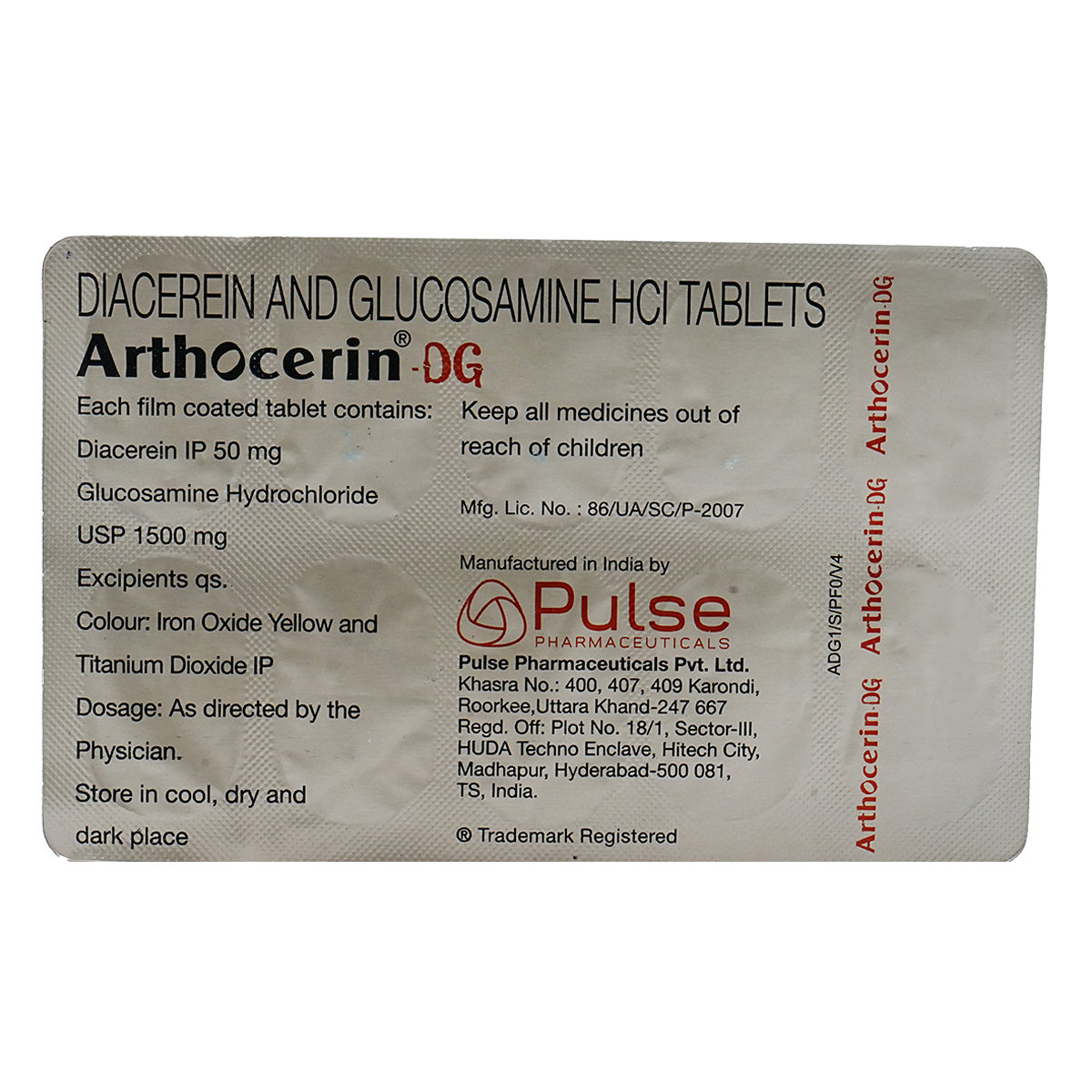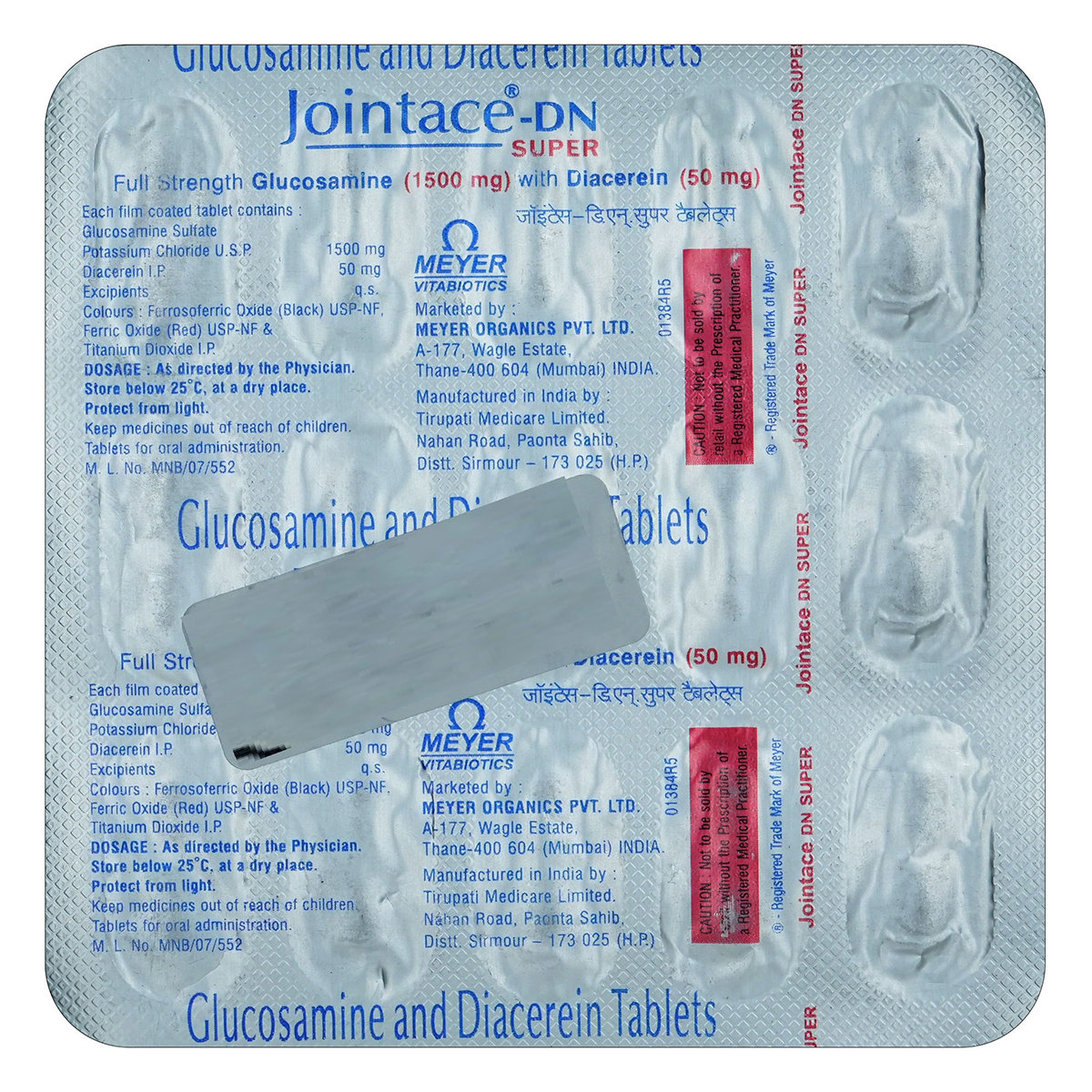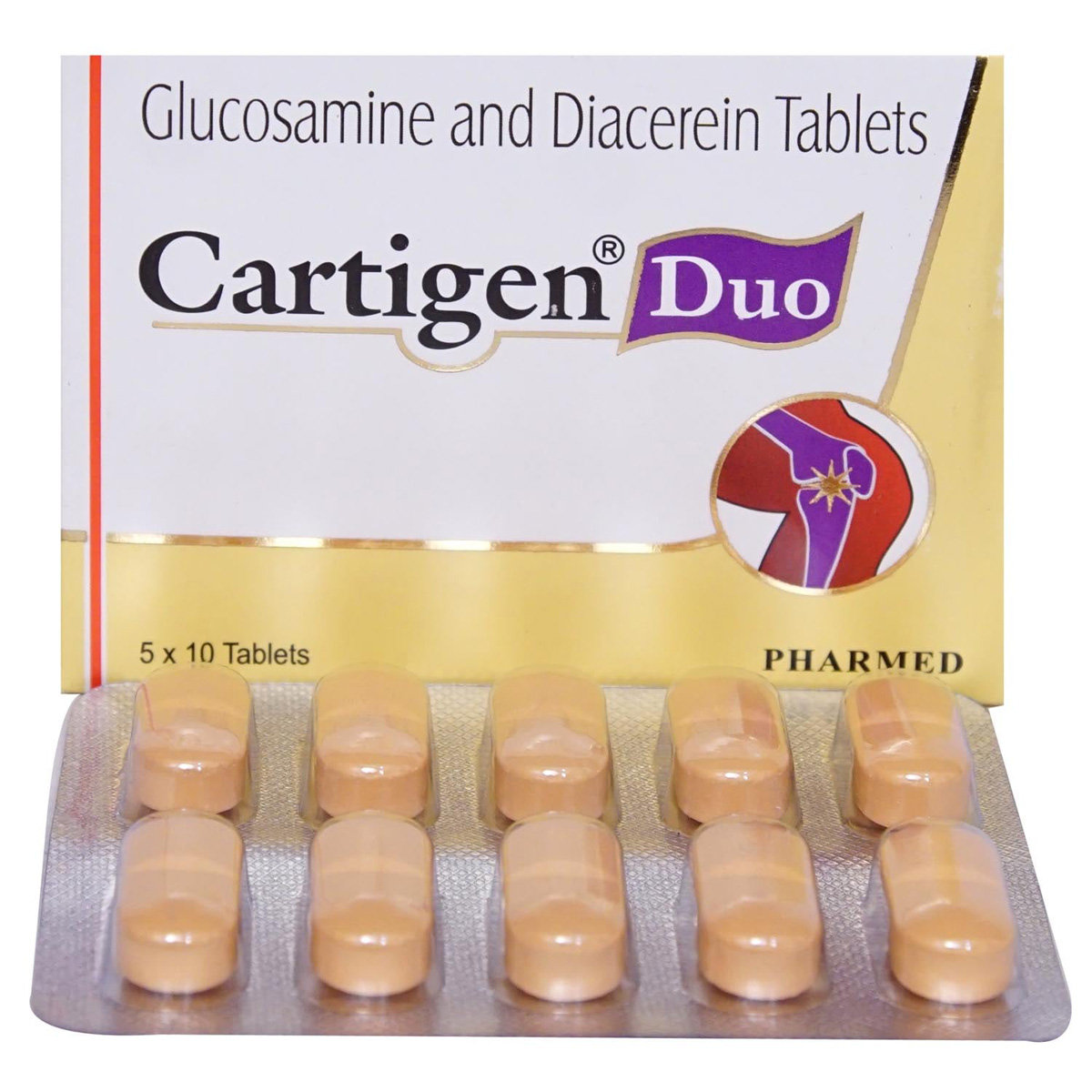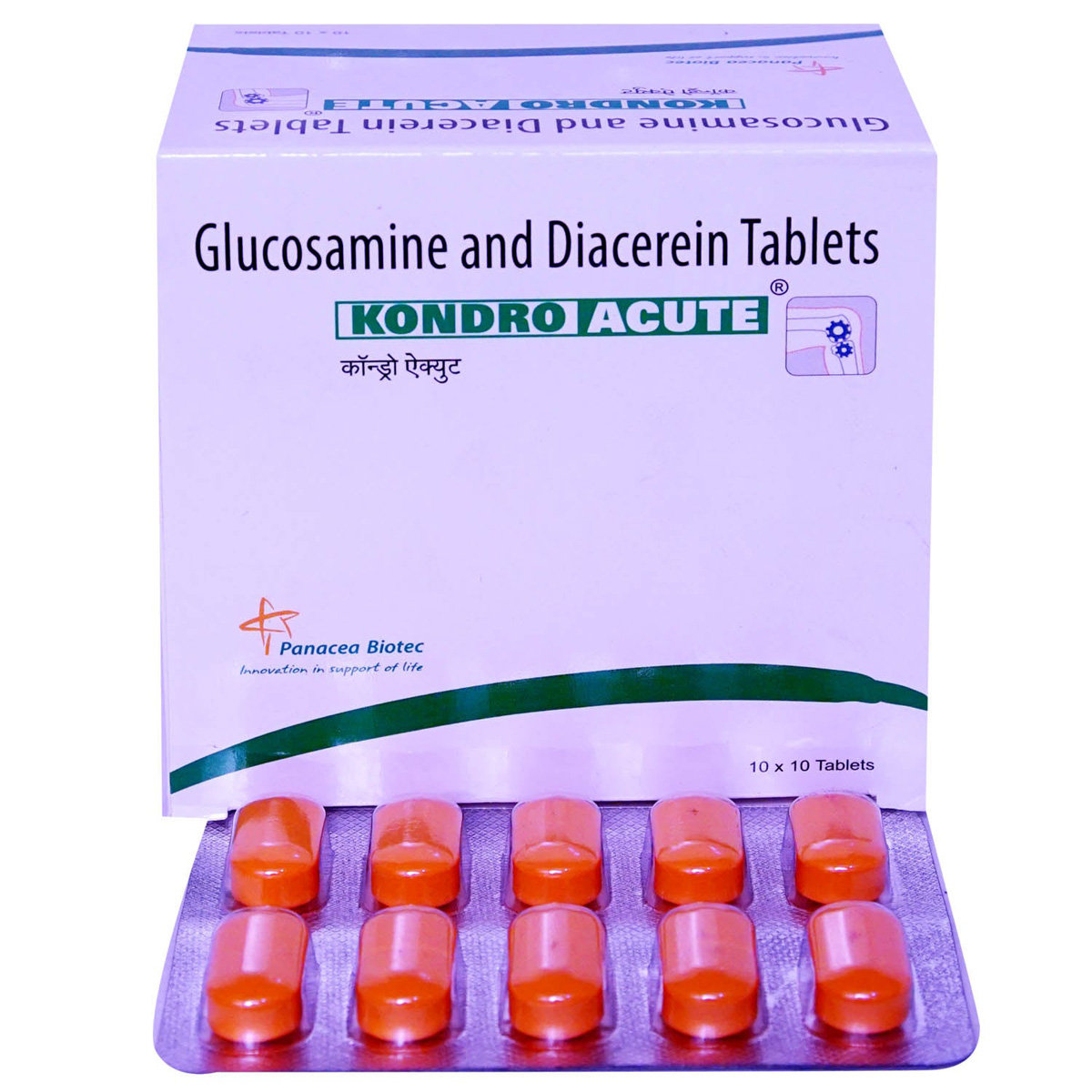- Home
- Ortho-Lead Tablet
Ortho-Lead Tablet Substitute
Ortho-Lead Tablet Substitute
Medicine Composition:
DIACEREIN-50MG + GLUCOSAMINE-1500MGAll Substitutes & Brand Comparisons
RX
Mahout DN Tablet
₹185.9
(₹16.73 per unit)
35% CHEAPERRX
Arthocerin DG Tablet 10's
Pulse Pharmaceuticals
₹200.5
(₹18.05 per unit)
30% CHEAPERRX
Arthovit GM 50mg/1500mg Tablet
Zedon Pharmaceuticals Pvt Ltd
₹210
(₹18.9 per unit)
27% CHEAPERRX
Dabrin-Gm Tablet
Snu Biocare
₹210
(₹18.9 per unit)
27% CHEAPERRX
Cartisafe D OD Tablet 10's
Jenburkt Pharmaceuticals Ltd
₹250.5
(₹22.55 per unit)
13% CHEAPERRX
Rinmin-OD Tablet 10's
Femura Pharmaceuticals Pvt Ltd
₹279
(₹25.11 per unit)
3% CHEAPERRX
Jointace DN Super Tablet 15's
Meyer Organics Pvt Ltd
₹450
(₹27.0 per unit)
3% COSTLIERRX
Cartigen Duo Tablet 10's
Pharmed Ltd
₹323
(₹29.07 per unit)
11% COSTLIERRX
Kondro Acute Tablet 10's
Panacea Biotec Ltd
₹339
(₹30.51 per unit)
16% COSTLIERRX
Gudjo - D Tablet 10's
Zentiva Pvt Ltd
₹345
(₹31.05 per unit)
18% COSTLIER

When Should You Consider Switching from Ortho-Lead Tablet ?
Patients may explore substitutes in the following scenarios:
- High monthly cost of Ortho-Lead Tablet
- Non-availability in local pharmacies
- Generic recommendation by a doctor
- Side effects or better tolerability with alternatives
What to Know Before Switching
Before you switch from Ortho-Lead Tablet to another medicine, here are some important points to keep in mind:
Same salt, different brands:
Most substitutes contain the same active ingredient - DIACEREIN-50MG + GLUCOSAMINE-1500MG, but the fillers, coating, or manufacturing quality may vary slightly.
Consult your doctor first:
Even if the salt is the same, your doctor can confirm if the substitute is right for your condition, dosage, and health history.
Watch out for allergies or reactions:
Some people may react differently to certain brands due to inactive ingredients. If you notice any side effects, inform your doctor immediately.
Price ≠ effectiveness:
A lower-priced substitute doesn't mean it's less effective. Many generic medicines work just as well as branded ones.
Check the dosage form and strength:
Always match the substitute’s strength (e.g., 5mg, 10mg) and form (tablet, capsule, syrup) with what your doctor prescribed.
Uses
Ortho-Lead Tablet is used in the treatment of osteoarthritis. The detailed uses of Ortho-Lead Tablet are as follows:
- Manages Osteoarthritis: Ortho-Lead Tablet helps to rebuild and protect cartilage (the cushioning tissue in joints), reducing wear and tear caused by osteoarthritis.
- Reduces joint pain and inflammation: Ortho-Lead Tablet helps relieve symptoms such as joint pain, stiffness, and swelling, thereby improving mobility and comfort.
- Slows joint damage: Ortho-Lead Tablet helps to slow the progression of joint degeneration and improve long-term joint health.
Medicinal Benefits
- Ortho-Lead Tablet comprises two medicines, namely diacerein and glucosamine.
- Diacerein restricts the action of a protein responsible for causing inflammation and destruction of cartilage, a process known as osteoarthritis.
- Glucosamine sulfate is a natural protein found in the body used by the body to produce a variety of chemicals responsible for building ligaments, cartilage, tendons, and the thick fluid surrounding joints.
- Ortho-Lead Tablet may either enhance the cartilage and fluid surrounding joints or prevent the breakdown of both components.
- In combination, both help form cartilage (the soft tissue that cushions the joints) and make the joints lubricated for better movement and flexibility.
- Ortho-Lead Tablet relieves pain, thereby improving joint function and helping individuals restore their quality of life.
- It also increases the cushioning and lubrication of joints, provides relief from pain, and makes physical activity easier.
FAQs
The substitutes of Ortho-Lead Tablet contain the same active salt(s) - DIACEREIN-50MG + GLUCOSAMINE-1500MG. However, they may differ in price, manufacturing quality, and inactive ingredients. Speak to your doctor to find a suitable option.
Switching to a generic substitute medicine in the place of Ortho-Lead Tablet is often possible if it has the same salt, strength, and dosage form. But always check with your doctor before making any changes to your medication.
Generics versions of Ortho-Lead Tablet are typically more affordable because they don’t include the original brand's research, development, and marketing costs. They contain the same active ingredient and are approved for safety and effectiveness.
Most people don’t notice any difference. However, some may react to different fillers or coatings. If you notice any unusual symptoms after switching, consult your doctor.
Make sure the new medicine has the same active salt, strength, dosage form. Always confirm the change with your doctor or pharmacist.
Substitutes of Ortho-Lead Tablet meet the same safety and efficacy standards as Ortho-Lead Tablet , but small differences in absorption or formulation can exist. A doctor can help you choose the right one for your needs.
Yes. Substitutes of Ortho-Lead Tablet may vary in color, size, or shape due to differences in manufacturing and branding, but this does not affect how they work.
Yes, it’s generally safe to switch between multiple substitutes of Ortho-Lead Tablet if they have the same salt and strength. However, always inform your doctor so they can monitor how your body responds.
Yes, many people safely use substitutes of Ortho-Lead Tablet for long-term treatment. Just ensure it’s done under medical supervision.
If your symptoms stay under control or lab results remain stable, the substitute for Ortho-Lead Tablet is likely working well. Regular follow-ups with your doctor are important.
Absolutely. Even with the same salt, small differences can affect how your body responds when switching from Ortho-Lead Tablet to its substitute. Always consult your doctor before switching.
Ortho-Lead Tablet is used to relieve pain associated with osteoarthritis. It helps form cartilage (the soft tissue that cushions the joints) and makes the joints lubricated for better movement and flexibility.
Ortho-Lead Tablet is not suggested in patients having liver problems. Ortho-Lead Tablet is also not administered to patients with known allergies to Ortho-Lead Tablet .
The safety and effectiveness of Ortho-Lead Tablet in joints other than the knee have not been established. So its use in parts other than the knee joint should be avoided.
Glucosamine sulfate is a natural protein found in the body used by the body to produce a variety of chemicals responsible for building ligaments, cartilage, tendons, and the thick fluid surrounding joints. Taking Ortho-Lead Tablet may either enhance the cartilage and fluid surrounding joints or prevent both components' breakdown.
You are advised to tell your doctor if you have diabetes, high cholesterol or triglycerides (a type of fat in the blood), cancer, liver disease, asthma, or other breathing disorder if you are allergic to shellfish, or you have taken a blood thinner (warfarin, Coumadin, Jantoven).
Some research suggests that the presence of Glucosamine in Ortho-Lead Tablet may affect antidiabetic drugs; it can also increase the sugar level in the blood in type 2 diabetes. This is why it is suggested to go for regular checkups of blood sugar with type 2 diabetes.
Ortho-Lead Tablet may increase the risk of bleeding in people taking Warfarin, so it is advised to tell your doctor if you are taking Warfarin or any other medicine.
Some research suggests that glucosamine sulfate may enhance insulin levels in the body which can increase blood pressure. To be safer side, go for regular blood checks and closely monitor your blood pressure.
It has been noticed that Ortho-Lead Tablet may cause allergic reactions in persons who are sensitive to shellfish. Glucosamine is produced synthetically from shells of shrimp, lobster, and crabs.
Some research suggests that Ortho-Lead Tablet may increase pressure inside the eye and may worsen glaucoma. So if you have glaucoma then tell to your doctor.
No, Ortho-Lead Tablet is not a steroid. This combination medication supports joint health by pairing Diacerein, which reduces inflammation and cartilage damage, with Glucosamine, which helps build and maintain joint cushioning. Together, they improve joint flexibility, reduce pain, and enhance movement.
Ortho-Lead Tablet works by reducing inflammation and protecting cartilage from damage. Diacerein blocks specific proteins that trigger joint inflammation, while Glucosamine promotes the production of cartilage and joint fluid. Together, they improve joint lubrication, reduce pain, and enhance mobility.
The optimal timing for taking Ortho-Lead Tablet is typically with meals, preferably breakfast or lunch, to enhance absorption and minimise gastrointestinal discomfort. However, it is crucial to adhere to the specific dosing instructions provided by your healthcare provider or pharmacist.
The common side effects of Ortho-Lead Tablet may include gastrointestinal issues such as nausea, abdominal pain, indigestion, diarrhoea, constipation, wind, and general symptoms like tiredness and headache. Most of these side effects are mild and temporary, resolving on their own over time. However, if they persist or worsen, it's essential to consult your doctor for proper evaluation and guidance.
Ortho-Lead Tablet is generally safe for most people, but if you have diabetes, you should use it with caution. Glucosamine may slightly affect blood sugar levels, so regular monitoring is crucial. Therefore, please consult the doctor before taking Ortho-Lead Tablet to ensure it’s safe for your condition and does not interfere with your diabetes management.
Ortho-Lead Tablet may take time to show noticeable effects. Diacerein usually starts working within 8 to 12 weeks, while the impact of Glucosamine may vary among individuals. Therefore, consistently following your doctor’s prescribed duration is key to achieving the best results.
Before taking Ortho-Lead Tablet , it's essential to inform your doctor if you have any pre-existing medical conditions, such as blood clots, circulation problems, pregnancy, breastfeeding, or plans to become pregnant. Additionally, disclose any joint infections, skin diseases, diabetes, kidney or liver problems, heart disease, or asthma. It's also essential to avoid drinking alcohol while taking this medication and note that it's not recommended for children under 18.
Ortho-Lead Tablet should be stored in a cool, dry place away from sunlight. Keep it out of sight and reach of children.
There is no specific evidence that Ortho-Lead Tablet increases the risk of developing glaucoma. However, some studies suggest that Glucosamine may raise intraocular pressure (IOP), a glaucoma risk factor. Therefore, please consult the doctor if you have glaucoma before using Ortho-Lead Tablet .
Buy best Orthopedics products by
Cipla Ltd
Sun Pharmaceutical Industries Ltd
Alkem Laboratories Ltd
Lupin Ltd
Intas Pharmaceuticals Ltd
Abbott India Ltd
Ajanta Pharma Ltd
Zydus Cadila
Zydus Healthcare Ltd
Torrent Pharmaceuticals Ltd
Dr Reddy's Laboratories Ltd
Macleods Pharmaceuticals Ltd
Prevego Healthcare & Research Pvt Ltd
Corona Remedies Pvt Ltd
Hetero Healthcare Pvt Ltd
Ipca Laboratories Ltd
Leeford Healthcare Ltd
Olcare Laboratories Pvt Ltd
RPG Life Sciences Ltd
Glenmark Pharmaceuticals Ltd
Wallace Pharmaceuticals Pvt Ltd
Cadila Healthcare Ltd
Emcure Pharmaceuticals Ltd
Overseas Health Care Pvt Ltd
United Biotech Pvt Ltd
Virchow Biotech Pvt Ltd
AGENEXT BIOPHARMA
Aar Ess Remedies Pvt Ltd
Actus Health Care
Ankaa Pharmaceutical
Bioelite Lifesciences Pvt Ltd
Blisson Mediplus Pvt Ltd
Brinton Pharmaceuticals Ltd
Chemo Healthcare Pvt Ltd
East West Pharma India Pvt Ltd
Eleadora Pharma
GlaxoSmithKline Pharmaceuticals Ltd
Inga Laboratories Pvt Ltd
Mankind Pharma Pvt Ltd
Medieos Life Sciences Llp
Medsol India Overseas Pvt Ltd
Pharmed Ltd
Rebanta Healthcare Pvt Ltd
Ronyd Healthcare Pvt Ltd
Synovion Laboratories Pvt Ltd
T Banko Genic Pharma
Talent India Pvt Ltd
Vasu Organics Pvt Ltd
Akumentis Healthcare Ltd
Alembic Pharmaceuticals Ltd
Alna Biotech Pvt Ltd
Arvincare
Aurolab
Bioshine Healthcare Pvt Ltd
CMG Biotech Pvt Ltd
Cadila Pharmaceuticals Ltd
Cell Salve Pharmaceutical
Celon Laboratories Pvt Ltd
Chemo Biological Ltd
Delcure Life Sciences Ltd
Dolvis Bio Pharma Pvt Ltd
Eins Pharmaceuticals
Elder Pharmaceuticals Ltd
Galpha Laboratories Ltd
Genesis Biotech
Hauz Pharma Pvt Ltd
Iifa Healthcare
Intra Labs India Pvt Ltd
Intra Life Pvt Ltd
La Renon Healthcare Pvt Ltd
Meyer Organics Pvt Ltd
Micro Labs Ltd
Msn Laboratories Pvt Ltd
Neon Laboratories Ltd
Novartis India Ltd
Panacea Biotec Ltd
Pulse Pharmaceuticals
Sanatra Healthcare Ltd
Tesla Labs
Xemex Life Sciences
Zee Laboratories Ltd
Acekinetics Healthcare Pvt Ltd
Akesiss Pharma Pvt Ltd
Alathea Biotec Pvt Ltd
Alexpen Remedies
Alteus Biogenics Pvt Ltd
Alvio Pharmaceuticals Pvt Ltd
Anthem Bio Pharma
Aten Remedies Pvt Ltd
Athens Labs Ltd
Aureate Healthcare
Biorange Biologicals Pvt Ltd
Biorex Healthcare Pvt Ltd
Cam Neuro Pharma Pvt Ltd
Care Formulation Labs Pvt Ltd
Celebrity Biopharma Ltd
Celera Healthcare Pvt Ltd
Comed Chemicals Ltd
Dewcare Concept Pvt Ltd
Dru Pharma Pvt Ltd







